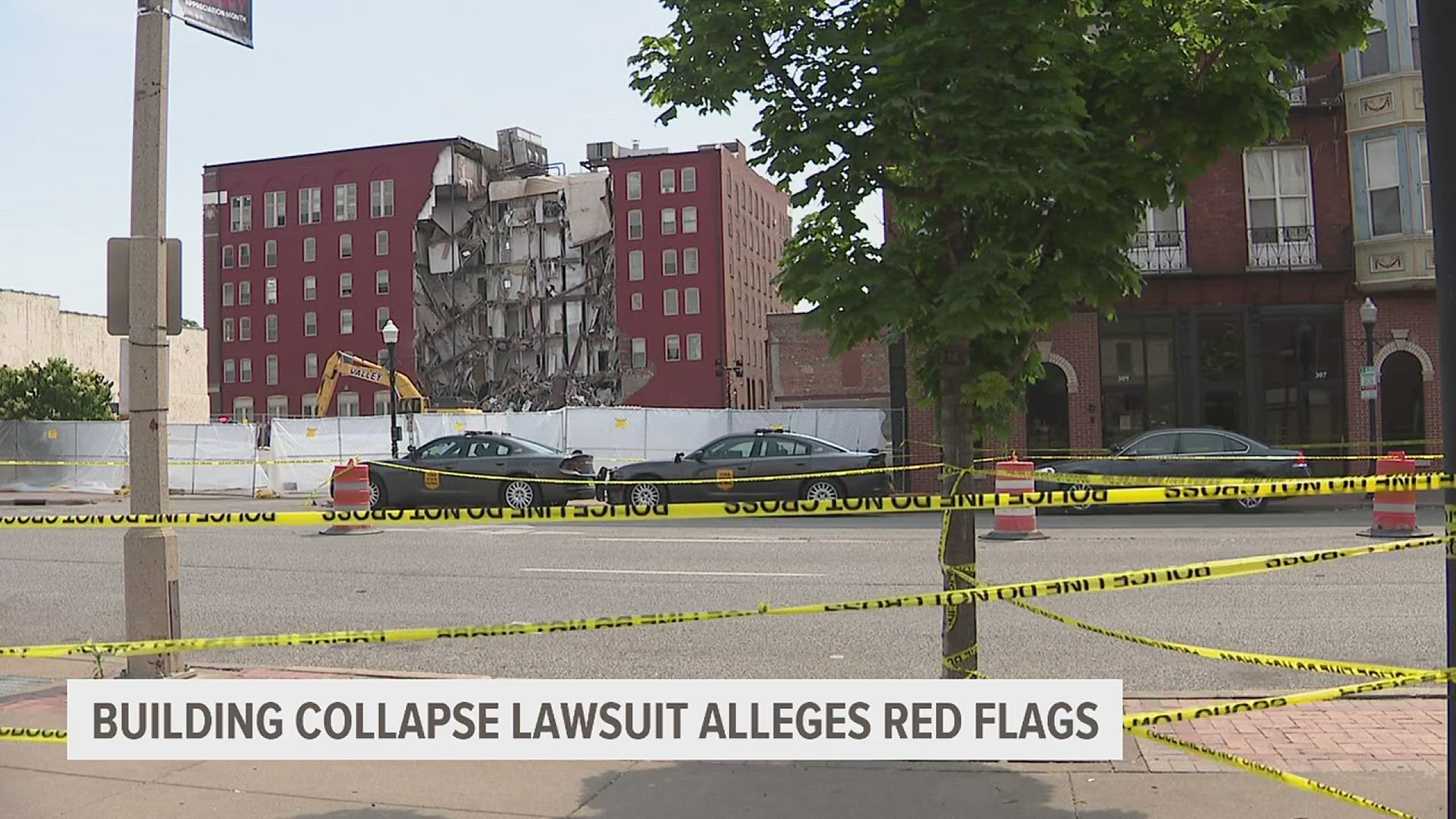DAVENPORT, Iowa — As crews on-site at 324 Main Street shift their focus from the recovery phase to dismantling the partially collapsed Davenport building, the lawsuits are just beginning to come in.
A lawsuit filed Monday on behalf of tenant Dayna Feuerbach accuses the City of Davenport and the building's current and former owners of knowing of the deteriorating conditions and failing to warn residents of the risk. It names building owner Andrew Wold, Davenport Hotel LLC, Andrew Wold Investments LLC, Select Structural Engineering, LLC, Bi-State Masonry, Inc., the City of Davenport, Waukee Investments I LLC and Parkwild Properties LC as defendants in the suit.
Feuerbach is represented by attorney Jeffrey Goodman of the Philadelphia-based firm of Saltz Mongeluzzi Bendesky, who specializes in structural collapse cases. He represented victims in the 2021 Surfside condominium collapse in Florida and that litigation ultimately settled for $1.2 billion. SMB attorney Samuel Dordick and DiCello Levitt's Chris Stombaugh also join the litigation team.
"There was red flag after red flag to the building owner, to the engineers, to the contractors and even to the City of Davenport, that this building was in a state of collapse and that a catastrophic event was inevitable and imminent," Goodman said. "(They) all had opportunity after opportunity to either help make the building safe, or at a minimum, demand that the residents evacuate the building."
He said the biggest red flag is looking at photos that were released that showed the deteriorating condition of the building.
Goodman also points to several memos written by an engineer at Select Structural Engineering over the course of the last few months, that detail the crumbling brick façade.
A final memo, included on page 29 of the lawsuit, dated May 24, just five days before the building collapsed, reads:
"To Whom It May Concern:
"A follow-up site visit was performed at the property above on May 23rd. On the west face of the building, there are several large patches of clay brick façade which are separating from the substrate. These large patches appear ready to fall imminently, which may create a safety hazard to cars or passerby ...
"As viewed from the west exterior, there are two former window openings, roughly 12 feet tall by six feet wide, which appear to have been bricked over some years ago. The clay brick façade on and between these openings is bulging outward by several inches and looks poised to fall. In anticipation of these areas falling, the brick façade above the windows should be secured. This is to keep the entire face of the building from falling away when the bottom area(s) come loose."
"If the residents had been evacuated, then this would be a very different conversation we'd have," Goodman said. "We'd be talking about a property damage issue, and not the loss of life and injuries that people have suffered. There is no excuse for the fact that nobody sounded that alarm of urgency and ordered the evacuation of the building."
Goodman noted several similarities between the partial collapse in Davenport and the collapse in Miami, including complaints that were ignored.
While he faults all the defendants in the lawsuit, it centers around Wold.
"We will be able to put him under oath and ask him the hard questions about why time and time again, he chose profits over safety," Goodman said. "Why, when given the opportunities to correct the hazard, he took the cheap way out? And why when he was told that this collapse was inevitable, did he not tell his residents to get out of the building? We'll get to ask him those questions. And I look forward to that opportunity."
Goodman and his team will begin requesting documents from the entities involved in the case, including internal communication between the companies and the daily job reports that contractors have. He also wants a structural engineer to inspect the rubble, but due to safety concerns, that won't occur until after the rest of the building is demolished.
"One of the first steps to understanding how a building collapsed is figuring out how it was built and how it's maintained for those years," he said.
He hopes the lawsuit brings about similar reform to what happened after the Surfside collapse, such as making sure work is properly stamped by engineers and licensed professionals. He also wants to hold those involved accountable.
"And help reform regulations, help improve enforcement, help ensure greater compliance so that tragedies like that hopefully don't happen in the future," Goodman said.
While this lawsuit has only been filed on behalf of one resident, Feuerbach, Goodman said he's been in contact with multiple current and former tenants and expects to file more lawsuits in the coming days and weeks.

